*My posts may contain affiliate links, which means I may receive a small commission, at no cost to you, if you make a purchase through a link! Thank you for supporting my website!*
Last updated on March 15th, 2024 at 12:52 pm
Wondering if all of your furniture should be the same color? Well, look no further because I have your answer!
Furniture should not be the same color throughout a room because it feels overly matching and mimics a store display room instead of an intentionally-styled home. Mixing and matching furniture colors in a room is preferable because it creates depth, contrast, and texture.
Now that we’ve got the basics out of the way, let’s break into the details a little further so you can choose the best color combination for your furniture.
Let’s dive in!
Quick Navigation: How To Mix & Match Furniture Colors
- Benefits Of Using Multiple Furniture Colors Instead Of The Same Furniture Color
- Rooms That Benefit From Mismatched Furniture
- How To Mix & Match Furniture Colors In A Living Room
- How To Mix & Match Furniture Colors In A Bedroom
- Other FAQs About Choosing Furniture Colors
- Final Thoughts
Benefits Of Using Multiple Furniture Colors Instead Of The Same Furniture Color
There are several benefits to using multiple furniture colors in a room instead of the same color.
These benefits include:
- Helps a room feel collected and intentional instead of store-bought
- Easier to incorporate older furniture pieces (instead of everything having to be store-bought new to match)
- Makes it easier to mix and match different styles in a room (the goal is to have 2 opposing styles in the same room to help a room avoid feeling too matchy-matchy)
If you already have some furniture pieces that you love and want to figure out what other pieces you can add to fill out your space, then using different furniture colors is the best solution for you.
When Can You Have All Furniture Be The Same Color?
Although this article is going to show you how to mix and match your furniture colors, I feel the need to say that there is absolutely nothing wrong with having all matching furniture in your home.
However, it can make your room feel too “matchy-matchy” if you don’t incorporate other textures, colors, and decorative items throughout the room.
In fact, in one of the rooms we’ve decorated, we went with a matching bedroom set because we liked all of the pieces and wanted to make the furniture shopping process simple.
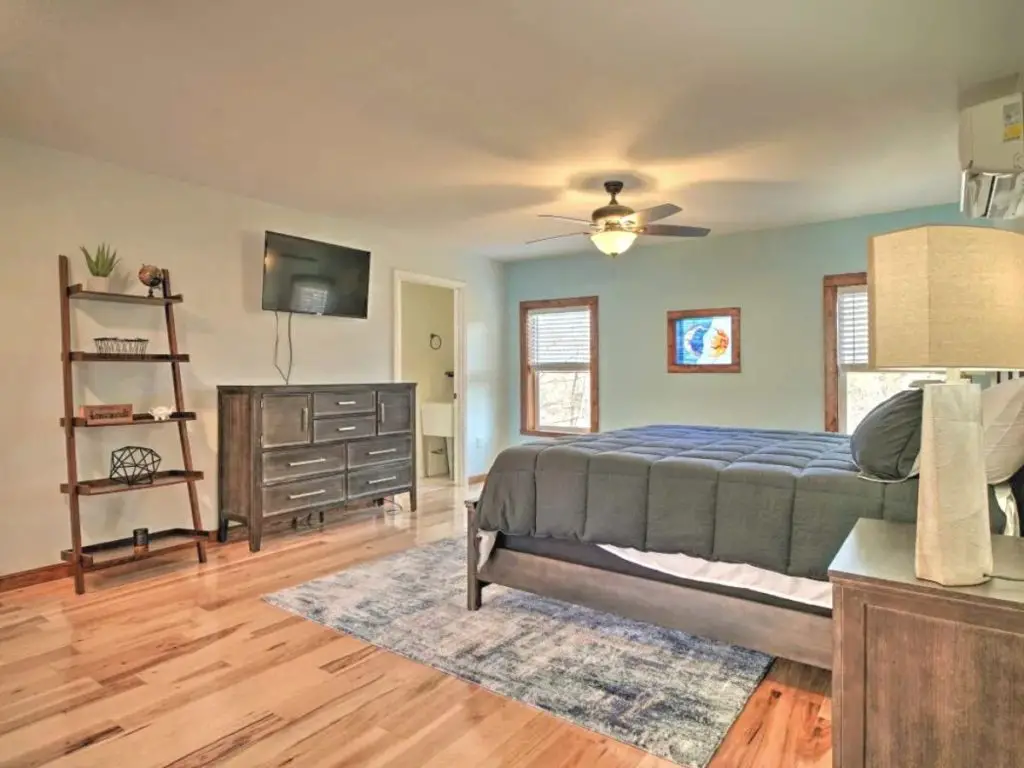
The room does not feel overly matching, though, because we incorporated other furniture pieces and decorations in the room to add to the dimension of the room.
We used:
- A different colored decorative ladder with several different colored, shaped, and textured knickknacks on it
- A large plant and mirror in the corner to a large organic item to the room
- Lamps and artwork overtop the nightstands along with a bold colored bedspread to draw your attention to different colors and textures by the bed (instead of the matching headboard and nightstands)
- A bold colored rug and a painted focal wall to add more contrast and texture to the room
- The wood trim, flooring, and doors all being different colors also already adds more variation in the room than most rooms have (so making the furniture be another color could make the room feel disjointed and piece-mealed together instead of feeling intentional and thought out)
Adding these other items makes it less important that the furniture is matching because our eyes are drawn to all of the other colors and textures throughout the room.
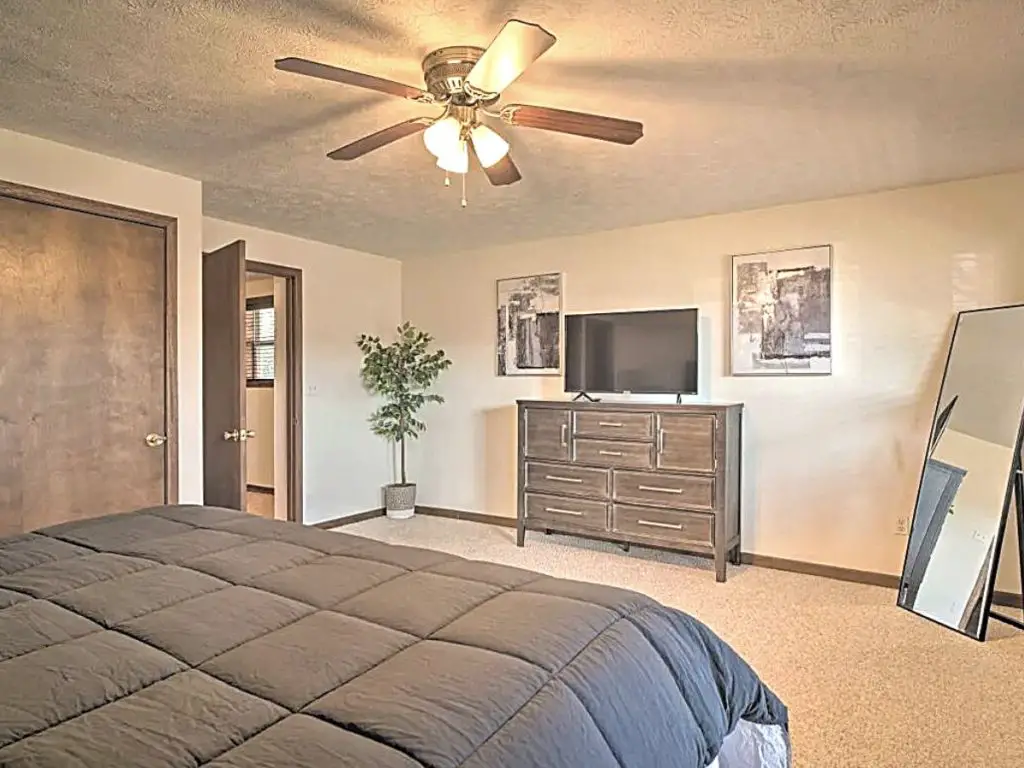
Although it can work out, it is now much more common to see different colors and styles mixed together in the same room to create depth, contrast, and texture.
If you look in your favorite home design magazine, you’ll notice that the furniture colors in the room complement each other, but they don’t match.
With that in mind, the rest of this article will help you accomplish a well-thought-out furniture color scheme to take a boring, drab room to a decorated masterpiece.
Rooms That Benefit From Mismatched Furniture
The rooms that greatly benefit from mismatched furniture are:
- Living rooms
- Bedrooms
Since both the living room and the bedroom have several pieces of furniture within them (and often, sitting right next to each other), there are the most opportunities to mix and match the furniture colors and styles in these two rooms.
While the general color rules are similar in both rooms, there are slight variations, so I’m going to discuss how to mix and match furniture in each of these two rooms separately.
Click here to jump to the section How To Mix & Match Furniture Colors In A Living Room.
Or click here to jump to the section How To Mix & Match Furniture Colors In A Bedroom.
How To Mix & Match Furniture Colors In A Living Room
Let’s dive into how to choose furniture colors in a living room.
Step One: Choose A Neutral Color For The Couch
First, you want to choose a neutral color for the couch.
Preferably, you want to choose a light neutral color (such as light gray, light beige, cream, or a light/muted shade of any other color you want) because:
- It helps the room appear bigger
- Lighter, neutral colors are easier to work with (will complement most other colors)
Also, the couch is the biggest, most expensive furniture piece in the living room, so keeping it neutral will help it fit into any style of home for years (even as the styles change over time).
Then you can swap out the decorations as the styles and seasons change more easily and for less money than having to swap out your couch whenever you want to switch up the look of your home.
Our house color scheme is a combination of gray, white, black, walnut wood, and green plants.
So we chose a light gray/beige sectional and a light gray recliner as our two base furniture pieces for our living room.
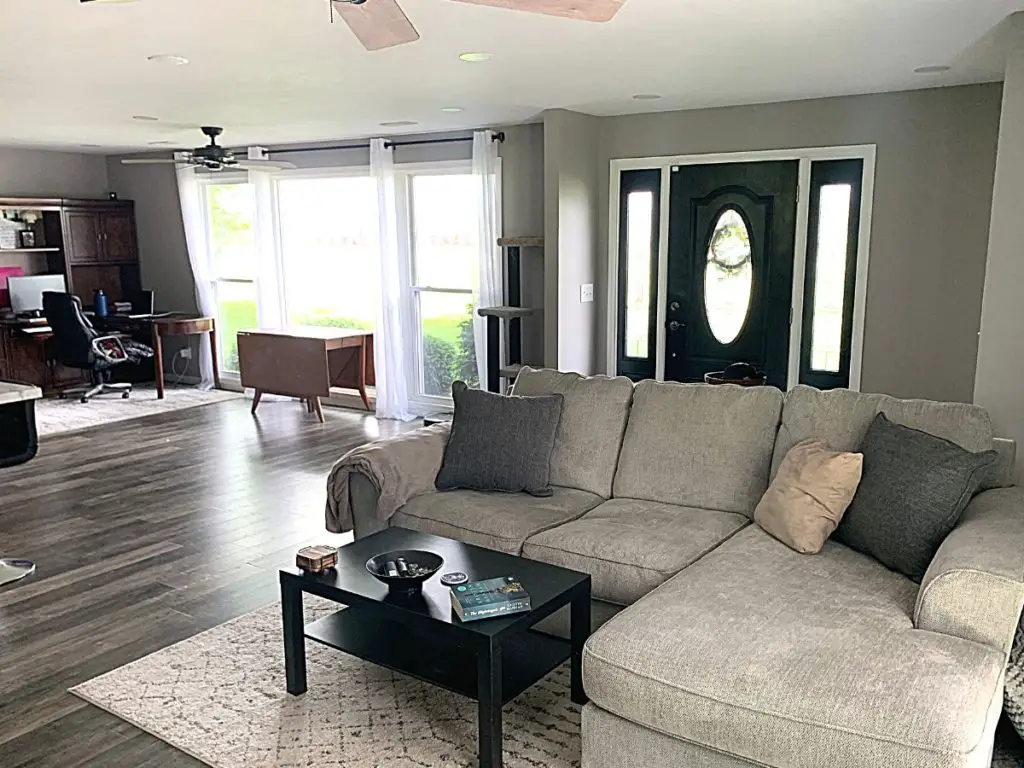
In the future, if I want to add an accent color throughout the home (such as blue or green), then I could easily change the color of the decorations/wall paint around the couch and recliner and they would fit right in with the new color scheme.
This is also a great time for me to recommend that you choose a light, neutral paint color for your walls as well. There are tons of benefits to choosing a light neutral paint color to paint your entire house.
You can read why I recommend these neutral paint colors and how to go about choosing one for your home here.
If you can’t get a new couch or already have a bold-colored couch that you love, then don’t worry. You can still follow the next steps to incorporate them into the design plan.
Step Two: Choose A Contrasting Color For The Side Tables
Next, you want to choose a contrasting color for the side tables.
To help the couch pop, choose a color that’s opposite the couch.
For example, if your couch is a light color, then choose a dark color/wood/metal for the side tables. Or if your couch is a dark color, then choose a light color/wood/metal for the side tables.
Also, using a different material from the couch (such as wood, metal, or glass) helps give visual contrast and another texture to the living room.
As a bonus design element, choose a different-shaped side table from your couch (such as round side tables for a rectangular-armed couch or square side tables for a round-armed couch).
This variety in shape also helps add visual contrast to the room.
For our living room, I’m still in the design stages, so I’m going to show you my design inspiration for what I’m planning to incorporate into our home.
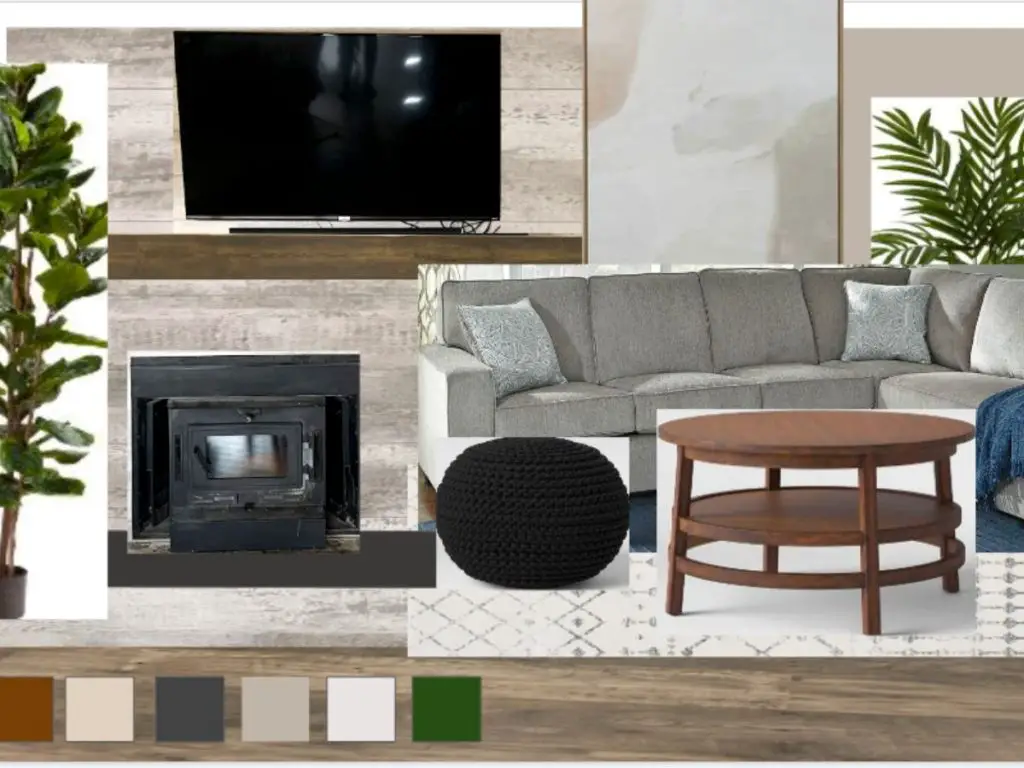
To contrast my rectangular, light gray/beige couch, I’m going to incorporate round black side tables.
Since my light gray recliner has a little more rounded features, I chose a simple black square side table for contrast.
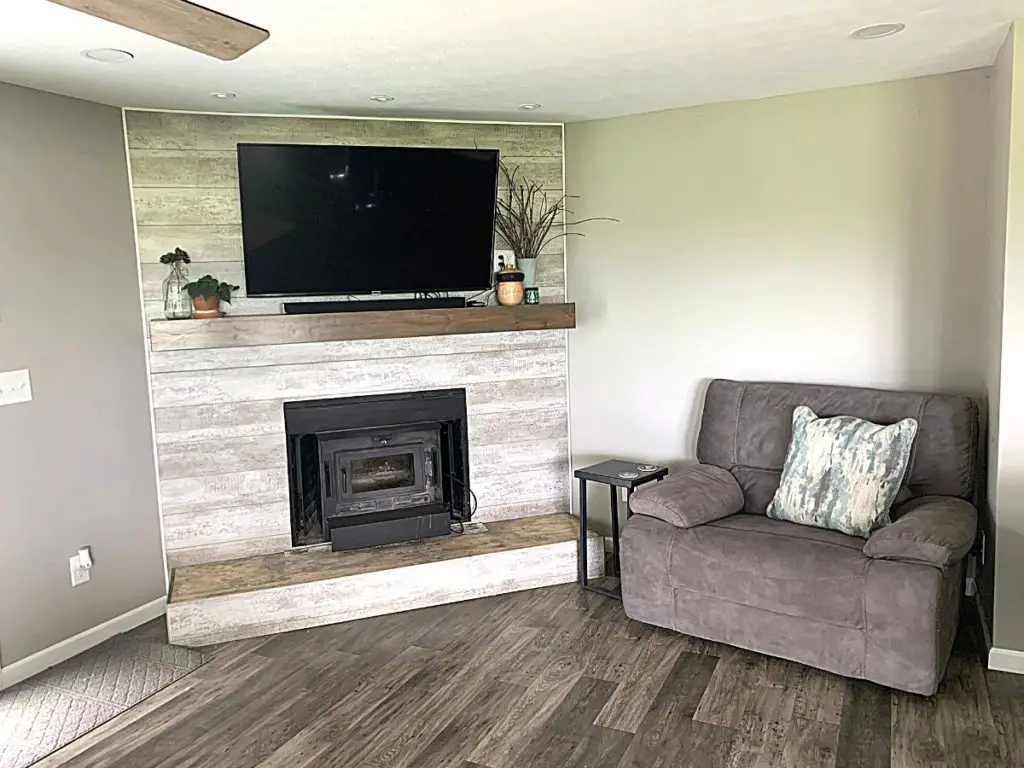
You could also choose a medium shade color and save your high contrast color for the next step.
Step Three: Choose An Inbetween Color For The Coffee Table
Next, you want to choose a medium color for the coffee table.
Since the coffee table and side tables are so close together, you want to choose a third color to help avoid making the area feel too heavy with a single color.
The best way to choose this in-between color is to choose a different type of material that’s in a medium color (wood, stone, glass, metal, etc).
For example, if the couch is light gray and the side tables are black, then choose a medium wood color such as walnut for the coffee table to bridge the gap between the two colors and add another natural texture to the room.
Again, that’s the color scheme I’m working towards in my own house.

Currently, I have a rectangular, black coffee table, and it isn’t complementing the couch as much as I’d like because there are a lot of hard lines going on in my living room.
As I continue to acquire furniture, I’m adding several more round pieces to help soften the room.
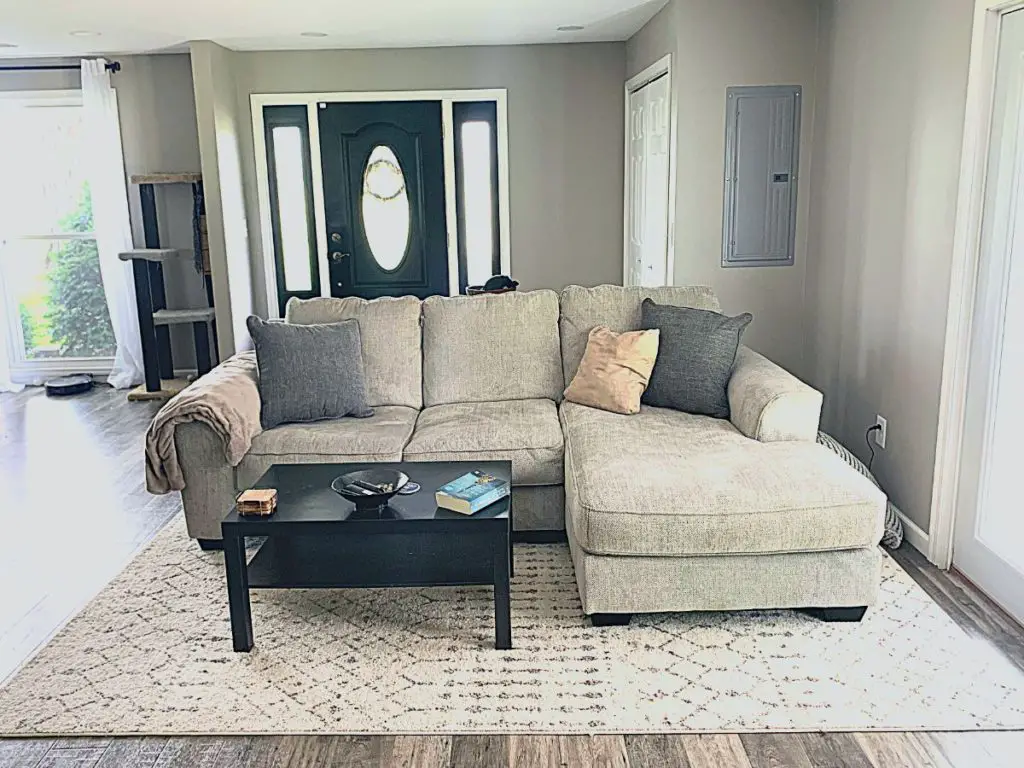
Another example could be a tan/brown couch with black metal side tables and a cream-colored or light wood-toned coffee table.
Or if you have other tables, dressers, or large pieces of furniture in the room in a third color, then you can simply match the color of the coffee table to the side tables and move on.
Regardless of the coffee table color chosen, make sure the shape of the coffee table (round, rectangular/square) is the same as the side tables to make them feel cohesive.
So if you chose round side tables, then choose a round coffee table as well.
You can also switch the colors of the side tables and the coffee table (make the coffee table the contrasting color and the side tables the in-between color) if that combination works better for your living room.
Step Four: Choose A Different Color/Textured Accent Chair
Finally, if you have the space, you want to choose a bold-colored accent chair.
This is where you can be creative and really show off your favorite style.
An accent chair can be a full-blown chair or something as simple as a small pouf you use as additional seating when guests come over.
Choose whatever color from your pallet that you feel you need a little more of in your living room. Or choose a totally random and bold color that complements all of the other colors in the room.
Some examples of accent chairs and side tables:
- Wood side table with black accent chair
- Metal side table with burnt orange leather accent chair
- White side table with wicker/rattan rocking chair
- Bold blue pouf that accents the blue in your throw pillows
If the only room you have is for a small pouf, then choose a color that’s found in your other decorations to tie it in. Such as a color in your throw pillows or wall decor.
Just as a reminder, you do not have to incorporate all four of these rules.
Just start with step 1 and continue down the list until you are satisfied with the combination of furniture colors and textures.
Each living room is unique and will call for a different furniture layout and requirements.
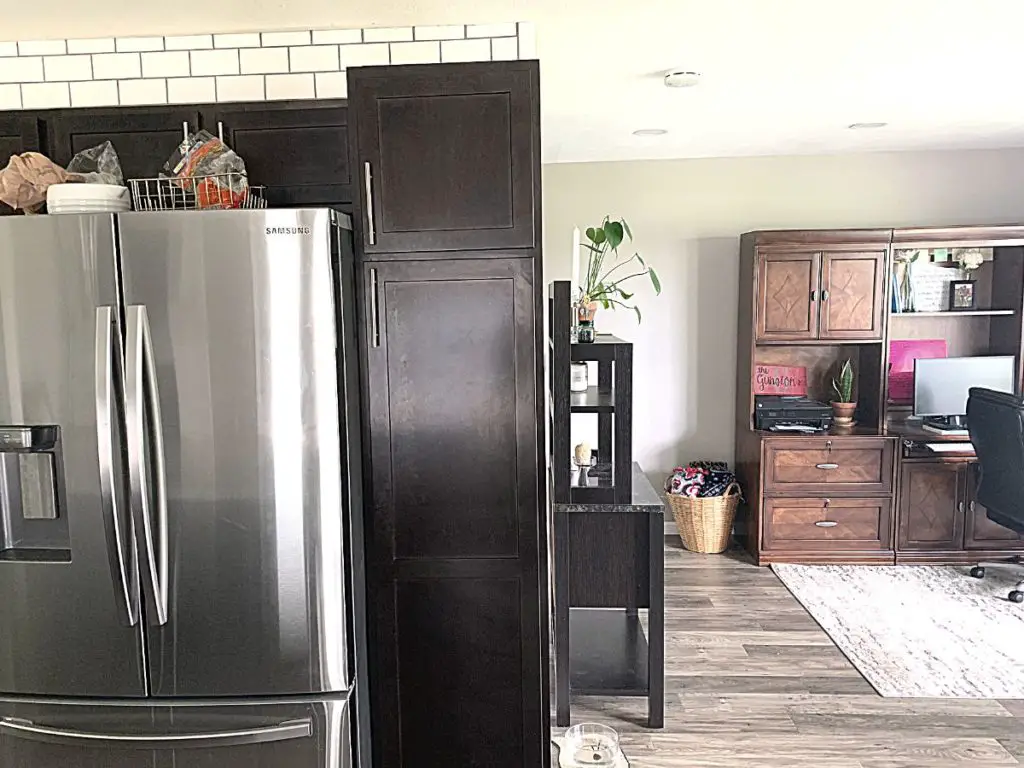
Now that we’ve covered the living room furniture, let’s go over the bedroom furniture!
How To Mix & Match Furniture Colors In A Bedroom
There are several steps to follow when choosing furniture colors for a bedroom.
Step One: Choose A Neutral Color For The Headboard & Bedframe
The concepts behind mixing and matching bedroom furniture is similar to the living room furniture.
You want to start by making the largest piece of furniture (i.e. the bed) a neutral color so that all of the other colors in the room will go well with it.
The headboard can be light or dark, and any material that matches your style (wood, metal, or upholstered).
Choose the headboard that speaks to you because it’s the largest piece in the room. Then choose all of your other decorations to complement the bedframe.
Also, consider the color of the sheets you have/want to use when choosing the headboard color.
Again, a neutral color is preferred because the largest piece needs to tie in all of the other pieces (white, gray, beige, or muted blues/greens go with many colors/wood tones)
After we finish decorating the living room, my plan is to tackle the master bedroom. As you can see, it’s small and almost bare. It looks exactly the same as when we moved in 2 years ago!
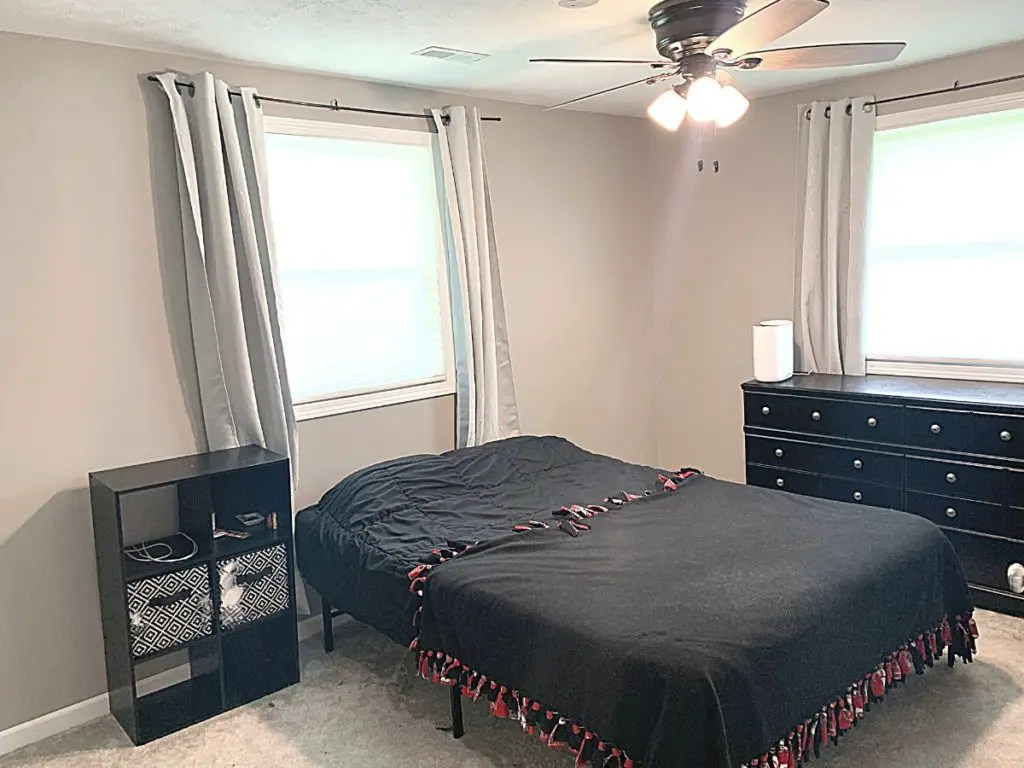
So here’s how I plan to style our bedroom.
I plan to DIY a light gray/beige upholstered bedframe (much the same color as our couch shown above).
We have cats that have dark fur and shed a lot. Their fur seems to show up on everything, so I’m not sure if I will switch from black bedsheets to white ones… but I do love the look and vibe of all white sheets!
Here’s my mood board, so you can get the idea of what I mean when I say choose a neutral bedframe and sheets.

Step Two: Choose A Contrasting Color For The Nightstands
Next, you want to choose a color that’s opposite the bedframe for the nightstands to help make the bed pop.
(Or as we discussed with the living room, make the nightstands the in-between color and the dresser the contrasting color.)
Using a different material as well (such as wood, metal, or glass) helps give visual contrast and an added texture to the bedroom.
And using a different shape (such as round nightstands for clean, straight-lined headboards/frames or square nightstands for more curvy/ornated headboards/frames) also helps add visual contrast to the room.
Since I want a gray upholstered headboard, the edges are a little rounded, so walnut, square/rectangular nightstands would look beautiful next to the headboard.
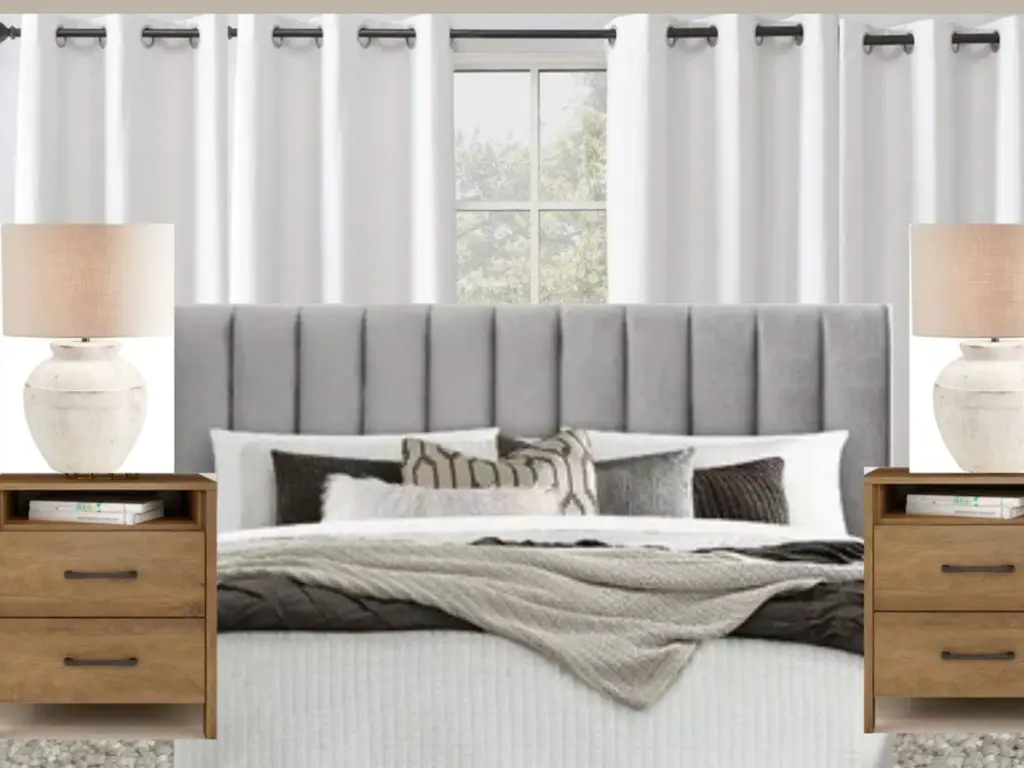
Step Three: Choose An Inbetween Color For The Dresser(s)
Next, choose an in-between color for the other dresser(s)/large storage pieces in the bedroom. (Or if the nightstands are the in-between color, make these the contrasting color.)
I already have a large, black dresser, so I plan to make that my contrasting piece of furniture and build 2 walnut (in-between color) nightstands to bridge the gap between the bed and the dresser colors.
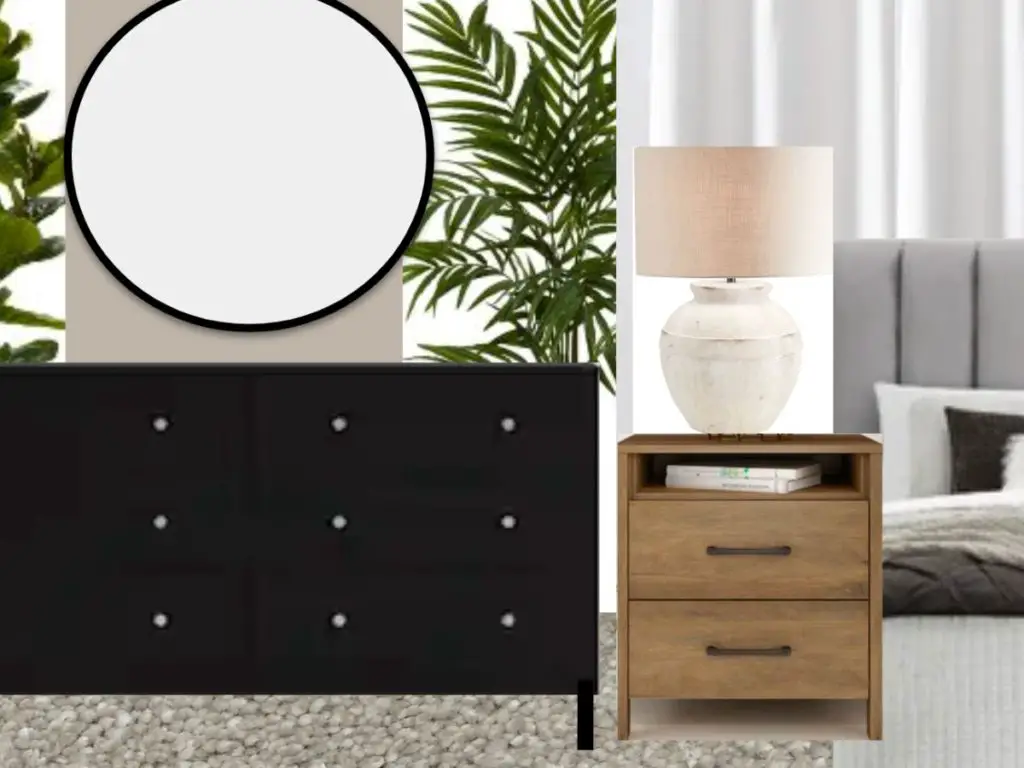
You could also use these furniture color combinations:
- Black metal bed frame, gray nightstands, and dark wood dresser
- Light wood headboard, white/cream nightstands, light gray dresser (or dresser with rattan/wicker)
In general, I like to keep the bedroom wall color and curtains light to help keep the room looking cozy and bright. That will help balance out a room that has heavy and dark furniture.
Step Four: (If You Have Extra Room) Add A Bench Or Accent Chair
Finally, if you have extra room, add a bench or accent chair to your bedroom.
If your bedroom is large enough to have a bench at the foot of the bed and/or a chair in the corner of the room then I recommend adding these furniture pieces.
They are super functional when you’re getting dressed, fill up the empty space nicely, and add another area to the bedroom where you can get creative.
This is where you can be creative and really show off your favorite style.
An accent chair is meant to stand out in the room as its own little area (usually a recliner or single-seat chair) with a side table next to it.
You can have your side table match the color of your nightstands or your dresser.
Then choose an accent chair that complements the side table. Look for a color that’s already in the room that you need a little more of.
And if you’re adding a bench, then you should choose its color the same way as the accent chair. Look for the color already in the room that you need a little more of.
For example, if you have a lot of whites/beiges and just a few wood items in the room, then choose a wood bench in the same color so it can enhance the existing color scheme.

Our master bedroom is a little wider than it is long (14 ft x 10 ft), so I don’t think I’ll be able to put a bench at the foot of the bed.
But I can put one in the extra space on the wall between the bedroom door and the bathroom door to create a small sitting space and an extra surface to decorate.
I want to incorporate the beautiful walnut wood of the nightstands on that side of the room, so I will probably choose a walnut bench as well.

That’s it! Once all of your furniture colors are selected, you can continue to layer in wall decorations and other knickknacks to fill out the rest of your bedroom.
Other FAQs About Choosing Furniture Colors
Here are some other frequently asked questions about choosing furniture colors to help you easily decorate your home.
Do Two Couches Have To Match?
It is common for two couches that are next to or adjacent to each other to match. Matching the couch colors will make the couch look like one continuous piece. Smaller chairs in the living room can be a different color to create an accent.
Can I Mix White & Wood Furniture?
White and wood furniture can easily be mixed together in the same room to create a unique, complementary, and natural color scheme. Bohemian-styled rooms often mix white and wood furniture to create an airy, bright, and natural vibe in a room.
Final Thoughts On Choosing Furniture Colors
There you have it!
Your furniture colors do not have to match 100% as they do inside store warehouses. Feel free to have fun with different styles, materials, colors, and textures to create a one-of-a-kind space that you love walking into daily!
Hopefully, these furniture color tips help you along your design journey as they are helping me with mine.
Catch you in my next post!
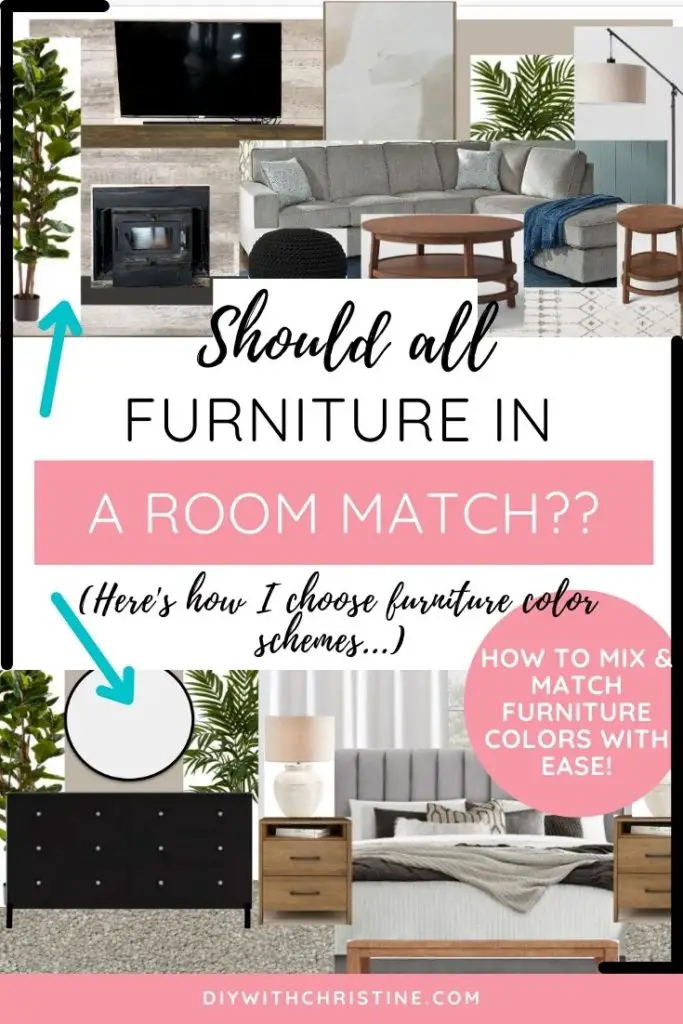

By Christine
Christine is a blogger and DIYer who tackles home renovation and decorating projects alongside her husband, Adam, for their personal residence and rental properties. Although she successfully tackles large renovation projects to avoid expensive contractor fees and bring her vision to life now, her path to success was not easy.
Go here to read her story, “From a Clueless First-Time Homebuyer To A Confident DIYer Creating Her Dream Home One Project At A Time“.
Popular Posts
DIY With Christine is a participant in the Amazon Services LLC Associates Program, an affiliate advertising program designed to provide a means for sites to earn advertising fees by advertising and linking to Amazon.com.






